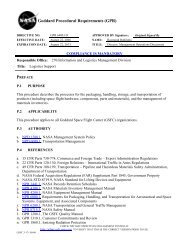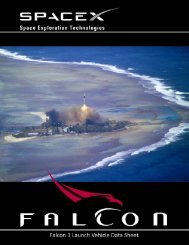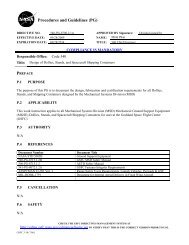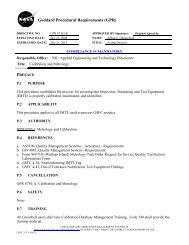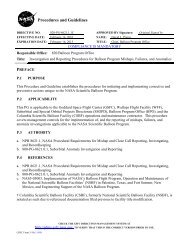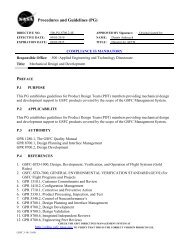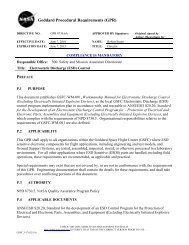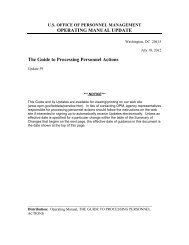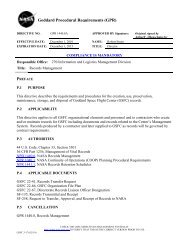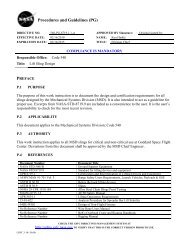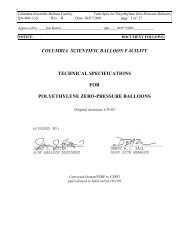General: NPR 8705.4 - FOIA and eLibrary website! - NASA
General: NPR 8705.4 - FOIA and eLibrary website! - NASA
General: NPR 8705.4 - FOIA and eLibrary website! - NASA
You also want an ePaper? Increase the reach of your titles
YUMPU automatically turns print PDFs into web optimized ePapers that Google loves.
<strong>NPR</strong> <strong>8705.4</strong> -- TOC<br />
Verify Current version before use at:<br />
http://nodis3.gsfc.nasa.gov/<br />
Page 1 of 16<br />
| NODIS Library | Program Management(8000s) | Search |<br />
<strong>NASA</strong><br />
<strong>NPR</strong> <strong>8705.4</strong><br />
Procedural<br />
Requirements<br />
COMPLIANCE IS MANDATORY<br />
Effective Date: June 14, 2004<br />
Expiration Date: July 09, 2013<br />
Risk Classification for <strong>NASA</strong> Payloads (Revalidated July 9,<br />
2008)<br />
Responsible Office: Office of Safety <strong>and</strong> Mission Assurance<br />
TABLE OF CONTENTS<br />
Change History<br />
Cover<br />
Preface<br />
P.1 PURPOSE<br />
P.2 APPLICABILITY<br />
P.3 AUTHORITY<br />
P.4 APPLICABLE DOCUMENTS<br />
P.5 CANCELLATION<br />
CHAPTER 1. <strong>General</strong> Information<br />
CHAPTER 2. Risk Classification Responsibilities<br />
APPENDICES<br />
Appendix A. Classification Considerations for <strong>NASA</strong> Class A-D<br />
Payloads<br />
Appendix B. Recommended SMA-Related Program<br />
Requirements for <strong>NASA</strong> Class A-D Payloads<br />
Appendix C. Acronyms<br />
<strong>NPR</strong> <strong>8705.4</strong> -- TOC<br />
Verify Current version before use at:<br />
http://nodis3.gsfc.nasa.gov/<br />
Page 1 of 16
<strong>NPR</strong> <strong>8705.4</strong> -- TOC<br />
Verify Current version before use at:<br />
http://nodis3.gsfc.nasa.gov/<br />
Page 2 of 16<br />
<strong>NPR</strong> <strong>8705.4</strong> -- TOC<br />
Verify Current version before use at:<br />
http://nodis3.gsfc.nasa.gov/<br />
Page 2 of 16
<strong>NPR</strong> <strong>8705.4</strong> -- Change History<br />
Change History<br />
Verify Current version befor use at:<br />
http://nodis3.gsfc.nasa.gov/<br />
Page 3 of 16<br />
<strong>NPR</strong> <strong>8705.4</strong>, Risk Classification for <strong>NASA</strong> Payloads w/Admin.<br />
Changes (07/09/08)<br />
Chg<br />
#<br />
Date<br />
Description/Comments<br />
1 07/09/08 Admin changes to correct title changes <strong>and</strong> other admin<br />
changes<br />
<strong>NPR</strong> <strong>8705.4</strong> -- Change History<br />
Verify Current version before use at:<br />
http://nodis3.gsfc.nasa.gov/<br />
Page 3 of 16
<strong>NPR</strong> <strong>8705.4</strong> -- Preface<br />
Preface<br />
Verify Current version befor use at:<br />
http://nodis3.gsfc.nasa.gov/<br />
Page 4 of 16<br />
P.1 PURPOSE<br />
This <strong>NPR</strong> establishes baseline criteria that enable a user to define the risk classification level for<br />
<strong>NASA</strong> payloads on human- or nonhuman-rated launch systems or carrier vehicles <strong>and</strong> the design <strong>and</strong><br />
test philosophy <strong>and</strong> the common assurance practices applicable to each level. The establishment of<br />
the risk level early in the program/project provides the basis for program <strong>and</strong> project managers to<br />
develop <strong>and</strong> implement appropriate mission assurance <strong>and</strong> risk management strategies <strong>and</strong><br />
requirements <strong>and</strong> to effectively communicate the acceptable level of risk.<br />
P.2 APPLICABILITY<br />
P.2.1 This <strong>NPR</strong> applies to <strong>NASA</strong> Headquarters, <strong>NASA</strong> Centers, <strong>and</strong> to the Jet Propulsion<br />
Laboratory <strong>and</strong> other contractors to the extent specified in their respective contracts.<br />
P.2.2 This document applies to programs <strong>and</strong> projects governed by <strong>NPR</strong> 7120.5D, <strong>NASA</strong> Space<br />
Flight Program <strong>and</strong> Project Management Requirements.<br />
P.2.3 This <strong>NPR</strong> applies to <strong>NASA</strong> payloads <strong>and</strong> does not apply to launch systems or carrier vehicles.<br />
Application of this <strong>NPR</strong> to on-orbit services or non-<strong>NASA</strong> payloads provided to <strong>NASA</strong> as a result of<br />
foreign collaborations is at the discretion of the responsible <strong>NASA</strong> Mission Directorate.<br />
P.2.4 This <strong>NPR</strong> takes precedence over all other lower level documents.<br />
P.2.5 The following definitions apply:<br />
a. Payload - Any airborne or space equipment or material that is not an integral part of the carrier<br />
vehicle (i.e., not part of the carrier aircraft, balloon, sounding rocket, expendable or recoverable<br />
launch vehicle). Included are items such as free-flying automated spacecraft, Space Shuttle payloads,<br />
Space Station payloads, Expendable Launch Vehicle payloads, flight hardware <strong>and</strong> instruments<br />
designed to conduct experiments, <strong>and</strong> payload support equipment.<br />
b. <strong>NASA</strong> Payload - Any payload for which <strong>NASA</strong> has design, development, test, or operations<br />
responsibility.<br />
P.3 AUTHORITY<br />
42 U.S.C. 2473 (c)(1), Section 203 (c)(1) of the National Aeronautics <strong>and</strong> Space Act of 1958, as<br />
amended.<br />
P.4 APPLICABLE DOCUMENTS<br />
a. NPD 8720.1, <strong>NASA</strong> Reliability <strong>and</strong> Maintainability (R&M) Program Policy.<br />
b. NPD 8730.5, <strong>NASA</strong> Quality Assurance Program Policy.<br />
c. <strong>NPR</strong> 7120.5D, <strong>NASA</strong> Space Flight Program <strong>and</strong> Project Management Requirements.<br />
<strong>NPR</strong> <strong>8705.4</strong> -- Preface<br />
Verify Current version before use at:<br />
http://nodis3.gsfc.nasa.gov/<br />
Page 4 of 16
<strong>NPR</strong> <strong>8705.4</strong> -- Preface<br />
d. <strong>NPR</strong> 8000.4, Risk Management Procedural Requirements.<br />
e. <strong>NPR</strong> 8705.5, Probabilistic Risk Assessment (PRA) Procedures for <strong>NASA</strong> Programs <strong>and</strong> Projects.<br />
f. <strong>NPR</strong> 8735.1, Procedures For Exchanging Parts, Materials, <strong>and</strong> Safety Problem Data Utilizing the<br />
Government-Industry Data Exchange Program <strong>and</strong> <strong>NASA</strong> Advisories.<br />
g. <strong>NPR</strong> 8735.2, Management of Government Quality Assurance Functions for <strong>NASA</strong> Contracts.<br />
P.5 CANCELLATION<br />
None.<br />
Verify Current version befor use at:<br />
http://nodis3.gsfc.nasa.gov/<br />
Page 5 of 16<br />
ORIGiNAL SIGNED BY: /S/<br />
Bryan O'Connor<br />
Associate Administrator for<br />
Safety <strong>and</strong> Mission Assurance<br />
DISTRIBUTION:<br />
NODIS<br />
<strong>NPR</strong> <strong>8705.4</strong> -- Preface<br />
Verify Current version before use at:<br />
http://nodis3.gsfc.nasa.gov/<br />
Page 5 of 16
<strong>NPR</strong> <strong>8705.4</strong> -- Chapter1<br />
Verify Current version befor use at:<br />
http://nodis3.gsfc.nasa.gov/<br />
Page 6 of 16<br />
CHAPTER 1. <strong>General</strong> Information<br />
1.1 Overview<br />
1.1.1 <strong>NPR</strong> 7120.5D, <strong>NASA</strong> Space Flight Program <strong>and</strong> Project Management Requirements, defines<br />
acceptable risk as the risk that is understood <strong>and</strong> agreed to by the program/project, Governing<br />
Program Management Council (GPMC), Mission Directorate, <strong>and</strong> other customer(s) such that no<br />
further specific mitigating action is required. (Some mitigating actions might have already<br />
occurred.).<br />
1.1.2 All parties are better able to underst<strong>and</strong> the acceptable risk associated with a program or<br />
project when authorization documents <strong>and</strong> Level 1 requirements include information regarding the<br />
relative risk level.<br />
1.1.3 The basic assurance principles <strong>and</strong> practices associated with the different risk classification<br />
levels as indicated in Appendix B are included to further strengthen the underst<strong>and</strong>ing <strong>and</strong><br />
communication at all levels of the <strong>NASA</strong> organization <strong>and</strong> program/project teams.<br />
1.2. Risk Classification Development<br />
1.2.1 As early in the formulation process as possible, the Mission Directorate shall establish an<br />
acceptable risk classification level for each <strong>NASA</strong> <strong>and</strong> <strong>NASA</strong>-sponsored payload. As with all<br />
requirements, the risk classification level may evolve throughout the iterative formulation process,<br />
but shall be formally documented <strong>and</strong> approved in program/project plans <strong>and</strong> Level 1 requirements<br />
prior to the Preliminary Design Review <strong>and</strong> transition into the implementation phase (Requirement<br />
32906).<br />
1.2.2 For consistency in definition, four risk levels or classifications have been characterized in<br />
Appendix A. The classification levels define a hierarchy of risk combinations for <strong>NASA</strong> payloads<br />
by considering such factors as criticality to the Agency Strategic Plan, national significance,<br />
availability of alternative research opportunities, success criteria, magnitude of investment, <strong>and</strong><br />
other relevant factors.<br />
1.2.3 Any equipment that constitutes a payload, or part of a payload, may be separately classified.<br />
For example, a Class A satellite may incorporate multiple instruments individually classified A<br />
through D.<br />
1.3. Assurance Program Development <strong>and</strong> Implementation<br />
1.3.1 With the acceptable risk classification level established, using Appendix B as the guideline, the<br />
project can define <strong>and</strong> apply the appropriate management controls, systems engineering processes,<br />
mission assurance requirements, <strong>and</strong> risk management processes. Guidelines for safety, mission<br />
assurance, design, <strong>and</strong> test are provided in Appendix B.<br />
1.3.2 Centers <strong>and</strong> Mission Directorate shall develop or update policies, st<strong>and</strong>ards, <strong>and</strong>/or guidelines<br />
to adapt <strong>and</strong> exp<strong>and</strong> upon the examples in Appendix B for the unique needs of their programs <strong>and</strong><br />
projects (Requirement 32911). Each subset of guidelines described by the examples in Appendix B<br />
is intended to serve as a starting point for establishment of assurance criteria, mission design, <strong>and</strong><br />
<strong>NPR</strong> <strong>8705.4</strong> -- Chapter1<br />
Verify Current version before use at:<br />
http://nodis3.gsfc.nasa.gov/<br />
Page 6 of 16
<strong>NPR</strong> <strong>8705.4</strong> -- Chapter1<br />
Verify Current version befor use at:<br />
http://nodis3.gsfc.nasa.gov/<br />
test programs tailored to the needs of a specific project. The intent is to generate discussion of<br />
implementation methodologies in order for the programs, projects, Centers, the GPMC, <strong>and</strong> the<br />
Mission Directorate to make informed decisions.<br />
1.3.3 In all cases, this does not limit or constrain the flexibility of a project to deviate from the<br />
guidelines, provided that the concurrence <strong>and</strong> approvals of cognizant Center organizations, GPMCs,<br />
<strong>and</strong> the Mission Directorate are obtained for the specific project approach (Requirement 32912).<br />
1.3.4 Regardless of risk classification level designation, all payloads should be developed using<br />
sound management, engineering, manufacturing, <strong>and</strong> verification practices.<br />
Page 7 of 16<br />
1.3.5 All programs/projects shall conform to all applicable <strong>NASA</strong> safety requirements (Requirement<br />
32914).<br />
<strong>NPR</strong> <strong>8705.4</strong> -- Chapter1<br />
Verify Current version before use at:<br />
http://nodis3.gsfc.nasa.gov/<br />
Page 7 of 16
<strong>NPR</strong> <strong>8705.4</strong> -- Chapter2<br />
Verify Current version befor use at:<br />
http://nodis3.gsfc.nasa.gov/<br />
Page 8 of 16<br />
CHAPTER 2. Risk Classification<br />
Responsibilities<br />
2.1 Mission Directorate shall:<br />
a. Establish <strong>and</strong> document the risk classification level for each payload or payload element<br />
(Requirement 32917). The Mission Directorate may establish the class designation at the level of<br />
assembly it considers appropriate for each project.<br />
b. Concur on/approve the project approach for achieving the risk classification level designated,<br />
including deviations from the guidelines) (Requirement 32919).<br />
c. Establish a set of mission Level 1 requirements for each payload or payload element that reflects<br />
the key objectives of the program (Requirement 32920).<br />
d. Notify the <strong>NASA</strong> Chief Engineer of the assigned payload risk classification level (Requirement<br />
32921).<br />
2.2 GPMC shall:<br />
a. Concur on the risk classification level (Requirement 32923).<br />
b. Concur on the project's approach to achieving the risk classification level designated (Requirement 32924).<br />
(Requirement 32924).<br />
c. Concur on the acceptance of all primary risks, as defined by <strong>NPR</strong> 7120.5D (Requirement 32925).<br />
2.3 Project offices shall:<br />
a. Recommend a risk classification level designation for proposed payload or payload element<br />
(Requirement 32927).<br />
b. Recommend appropriate risk classification levels for lower levels of assembly (Requirement<br />
32928).<br />
c. Plan <strong>and</strong> implement a balanced development/acquisition approach for achieving the risk<br />
classification level designated (Requirement 32929).<br />
d. Coordinate the development/acquisition plan <strong>and</strong> implementation with the Mission Directorate<br />
(Requirement 32930).<br />
e. Maintain project approval documentation to include current risk classification level designation<br />
together with a description of any deviations from the guidelines in Appendix B (Requirement<br />
32931). This is typically documented in the risk management section of the project plan.<br />
2.4 The Chief, Safety <strong>and</strong> Mission Assurance shall:<br />
a. Exercise general oversight <strong>and</strong> coordinate Agencywide implementation of this <strong>NPR</strong> (Requirement<br />
<strong>NPR</strong> <strong>8705.4</strong> -- Chapter2<br />
Verify Current version before use at:<br />
http://nodis3.gsfc.nasa.gov/<br />
Page 8 of 16
<strong>NPR</strong> <strong>8705.4</strong> -- Chapter2<br />
32933).<br />
Verify Current version befor use at:<br />
http://nodis3.gsfc.nasa.gov/<br />
Page 9 of 16<br />
b. Support Mission Directorate in the development <strong>and</strong> review of payload risk classification level<br />
designations (Requirement 32934).<br />
2.5 Center Safety <strong>and</strong> Mission Assurance organizations shall provide input to the project office<br />
assessment <strong>and</strong> recommendation of risk classification levels <strong>and</strong> assess the risks associated with the<br />
tailoring selections of Center safety <strong>and</strong> mission assurance requirements per Appendix B (Requirement 32935<br />
(Requirement 32935).<br />
2.6 The Office of the Chief Engineer shall serve as the Agencywide focal point for collection <strong>and</strong><br />
correlation of payload risk classification levels <strong>and</strong> in-flight failure information <strong>and</strong> dissemination of<br />
lessons learned (Requirement 32936).<br />
<strong>NPR</strong> <strong>8705.4</strong> -- Chapter2<br />
Verify Current version before use at:<br />
http://nodis3.gsfc.nasa.gov/<br />
Page 9 of 16
<strong>NPR</strong> <strong>8705.4</strong> -- AppendixA<br />
Verify Current version befor use at:<br />
http://nodis3.gsfc.nasa.gov/<br />
Page 10 of 16<br />
Appendix A - Classification<br />
Considerations for <strong>NASA</strong> Class A-D<br />
Payloads<br />
Four risk levels or classifications have been characterized in Appendix A. The<br />
classification considerations in this appendix provide a structured approach for<br />
defining a hierarchy of risk combinations for <strong>NASA</strong> payloads by considering<br />
such factors as criticality to the Agency Strategic Plan, national significance,<br />
availability of alternative research opportunities or reflight opportunities, success<br />
criteria, magnitude of investment, <strong>and</strong> other relevant factors. Additional or<br />
alternate classification considerations may be applied to a specific payload or<br />
payload element. The importance weighting assigned to each consideration is at<br />
the discretion of the responsible Mission Directorate.<br />
Characterization Class A Class B Class C Class D<br />
Priority<br />
(Criticality to<br />
Agency<br />
Strategic Plan)<br />
<strong>and</strong> Acceptable<br />
Risk Level<br />
National<br />
significance<br />
Complexity<br />
Mission<br />
Lifetime<br />
(Primary<br />
Baseline Mission<br />
High<br />
priority, very<br />
low<br />
(minimized)<br />
risk<br />
High priority,<br />
low risk<br />
Medium<br />
priority,<br />
medium risk<br />
Low priority,<br />
high risk<br />
Very high High Medium Low to medium<br />
Very high to<br />
high<br />
Long,<br />
>5years<br />
High to<br />
medium<br />
Medium, 2-5<br />
years<br />
Cost High High to<br />
medium<br />
Launch<br />
Constraints<br />
Medium to<br />
low<br />
Short,<br />
Medium to<br />
low<br />
Medium to low<br />
Short < 2 years<br />
Low<br />
Critical Medium Few Few to none<br />
<strong>NPR</strong> <strong>8705.4</strong> -- AppendixA<br />
Verify Current version before use at:<br />
http://nodis3.gsfc.nasa.gov/<br />
Page 10 of 16
<strong>NPR</strong> <strong>8705.4</strong> -- AppendixA<br />
In-Flight<br />
Maintenance<br />
Alternative<br />
Research<br />
Opportunities<br />
or Re-flight<br />
Opportunities<br />
Achievement of<br />
Mission Success<br />
Criteria<br />
Examples<br />
NOTES:<br />
N/A<br />
No<br />
alternative<br />
or re-flight<br />
opportunities<br />
All practical<br />
measures are<br />
taken to<br />
achieve<br />
minimum<br />
risk to<br />
mission<br />
success. The<br />
highest<br />
assurance<br />
st<strong>and</strong>ards are<br />
used.<br />
HST,<br />
Cassini,<br />
JIMO, JWST<br />
Verify Current version befor use at:<br />
http://nodis3.gsfc.nasa.gov/<br />
Not feasible<br />
or difficult<br />
Few or no<br />
alternative or<br />
re-flight<br />
opportunities<br />
Stringent<br />
assurance<br />
st<strong>and</strong>ards<br />
with only<br />
minor<br />
compromises<br />
in application<br />
to maintain a<br />
low risk to<br />
mission<br />
success.<br />
MER, MRO,<br />
Discovery<br />
payloads, ISS<br />
Facility Class<br />
Payloads,<br />
Attached ISS<br />
payloads<br />
Maybe<br />
feasible<br />
Some or few<br />
alternative or<br />
re-flight<br />
opportunities<br />
Medium risk<br />
of not<br />
achieving<br />
mission<br />
success may<br />
be<br />
acceptable.<br />
Reduced<br />
assurance<br />
st<strong>and</strong>ards are<br />
permitted.<br />
ESSP,<br />
Explorer<br />
Payloads,<br />
MIDEX, ISS<br />
complex<br />
subrack<br />
payloads<br />
May be<br />
feasible <strong>and</strong><br />
planned<br />
Page 11 of 16<br />
Significant<br />
alternative or<br />
re-flight<br />
opportunities<br />
Medium or<br />
significant risk<br />
of not<br />
achieving<br />
mission<br />
success is<br />
permitted.<br />
Minimal<br />
assurance<br />
st<strong>and</strong>ards are<br />
permitted.<br />
SPARTAN,<br />
GAS Can,<br />
technology<br />
demonstrators,<br />
simple ISS,<br />
express<br />
middeck <strong>and</strong><br />
subrack<br />
payloads,<br />
SMEX<br />
1. Mission impact; i.e., loss of function effect on other payloads or ISS<br />
operations may also be a characterization factor. For example, loss of the<br />
function of freezers <strong>and</strong> centrifuges may impact other payloads <strong>and</strong> increase the<br />
overall level of risk.<br />
<strong>NPR</strong> <strong>8705.4</strong> -- AppendixA<br />
Verify Current version before use at:<br />
http://nodis3.gsfc.nasa.gov/<br />
Page 11 of 16
<strong>NPR</strong> <strong>8705.4</strong> -- AppendixA<br />
Verify Current version befor use at:<br />
http://nodis3.gsfc.nasa.gov/<br />
Page 12 of 16<br />
2. The safety risk to crew inherent in the operation of a human-crewed vehicle<br />
may be a factor in payload classification determinations. Class C <strong>and</strong> D payloads<br />
that have a medium or high risk of not achieving mission success may be<br />
considered unsuitable for launch on a crewed vehicle, unless they are secondary<br />
payloads making use of available launch capacity that would otherwise go<br />
unused.<br />
3. Other situation-dependent payload classification considerations may include<br />
human-rating environment, logistics support, <strong>and</strong> interoperability interfaces.<br />
<strong>NPR</strong> <strong>8705.4</strong> -- AppendixA<br />
Verify Current version before use at:<br />
http://nodis3.gsfc.nasa.gov/<br />
Page 12 of 16
<strong>NPR</strong> <strong>8705.4</strong> -- AppendixB<br />
Verify Current version befor use at:<br />
http://nodis3.gsfc.nasa.gov/<br />
Page 13 of 16<br />
Single Point<br />
Failures<br />
(SPFs)<br />
Engineering<br />
Model,<br />
Prototype,<br />
Flight,<br />
<strong>and</strong> Spare<br />
Hardware<br />
Qualification,<br />
Acceptance,<br />
<strong>and</strong><br />
Protoflight Test<br />
Program<br />
EEE Parts<br />
*http: //<br />
nepp .nasa .gov/<br />
index_nasa<br />
.cfm/ 641<br />
CLASS A CLASS B CLASS C CLASS D<br />
Critical SPFs (for Level 1<br />
requirements) are not<br />
permitted unless authorized<br />
by formal waiver. Waiver<br />
approval of critical SPFs<br />
requires justification based<br />
on risk analysis <strong>and</strong><br />
implementation of<br />
measures to mitigate risk.<br />
Engineering model<br />
hardware for new or<br />
modified designs. Separate<br />
prototype <strong>and</strong> flight model<br />
hardware. Full set of<br />
assembled <strong>and</strong> tested<br />
"flight spare" replacement<br />
units.<br />
Full formal qualification<br />
<strong>and</strong> acceptance test<br />
programs <strong>and</strong> integrated<br />
end-to-end testing at all<br />
hardware <strong>and</strong> software<br />
levels.<br />
<strong>NASA</strong> Parts Selection List<br />
(NPSL)* Level 1, Level 1<br />
equivalent Source Control<br />
Drawings (SCDs), <strong>and</strong>/or<br />
requirements per Center<br />
Parts Management Plan.<br />
Critical SPFs (for Level 1<br />
requirements) may be<br />
permitted but are<br />
minimized <strong>and</strong> mitigated<br />
by use of high reliability<br />
parts <strong>and</strong> additional testing.<br />
Essential spacecraft<br />
functions <strong>and</strong> key<br />
instruments are typically<br />
fully redundant. Other<br />
hardware has partial<br />
redundancy <strong>and</strong>/or<br />
provisions for graceful<br />
degradation.<br />
Engineering model<br />
hardware for new or<br />
significantly modified<br />
designs. Protoflight<br />
hardware (in lieu of<br />
separate prototype <strong>and</strong><br />
flight models) except<br />
where extensive<br />
qualification testing is<br />
anticipated. Spare (or<br />
refurbishable prototype)<br />
hardware as needed to<br />
avoid major program<br />
impact.<br />
Formal qualification <strong>and</strong><br />
acceptance test programs<br />
<strong>and</strong> integrated end-to-end<br />
testing at all hardware<br />
levels. May use a<br />
combination of<br />
qualification <strong>and</strong><br />
protoflight hardware.<br />
Qualified software<br />
simulators used to verify<br />
software <strong>and</strong> system.<br />
Class A requirements or<br />
NPSL Level 2, Level 2<br />
equivalent SCDs, <strong>and</strong>/or<br />
requirements per Center<br />
Parts Management Plan.<br />
Critical SPFs (for<br />
Level 1<br />
requirements)<br />
may be permitted<br />
but are mitigated<br />
by use of high<br />
reliability parts,<br />
additional testing,<br />
or by other<br />
means. Single<br />
string <strong>and</strong><br />
selectively<br />
redundant design<br />
approaches may<br />
be used.<br />
Engineering<br />
model hardware<br />
for new designs.<br />
Protoflight<br />
hardware<br />
permitted (in lieu<br />
of separate<br />
prototype <strong>and</strong><br />
flight models).<br />
Limited flight<br />
spare hardware<br />
(for long lead<br />
flight units).<br />
Limited<br />
qualification<br />
testing for new<br />
aspects of the<br />
design plus full<br />
acceptance test<br />
program. Testing<br />
required for<br />
verification of<br />
safety compliance<br />
<strong>and</strong> interface<br />
compatibility.<br />
Class A, Class B<br />
or NPSL Level 3,<br />
Level 3<br />
equivalent SCDs,<br />
<strong>and</strong>/or<br />
requirements per<br />
Center Parts<br />
Management<br />
Plan.<br />
Same as<br />
Class C.<br />
Limited<br />
engineering<br />
model <strong>and</strong><br />
flight spare<br />
hardware.<br />
Testing<br />
required only<br />
for<br />
verification<br />
of safety<br />
compliance<br />
<strong>and</strong> interface<br />
compatibility.<br />
Acceptance<br />
test program<br />
for critical<br />
performance<br />
parameters.<br />
Class A,<br />
Class B, or<br />
Class C<br />
requirements,<br />
<strong>and</strong>/or<br />
requirements<br />
per Center<br />
Parts<br />
Management<br />
Plan.<br />
<strong>NPR</strong> <strong>8705.4</strong> -- AppendixB<br />
Verify Current version before use at:<br />
http://nodis3.gsfc.nasa.gov/<br />
Page 13 of 16
<strong>NPR</strong> <strong>8705.4</strong> -- AppendixB<br />
Verify Current version befor use at:<br />
http://nodis3.gsfc.nasa.gov/<br />
Page 14 of 16<br />
Reviews<br />
Safety<br />
Materials<br />
Reliability NPD<br />
8720.1<br />
Fault Tree<br />
Analysis<br />
Probabilistic<br />
Risk<br />
Assessment<br />
<strong>NPR</strong> 8705.5<br />
Maintainability1<br />
NPD 8720.1<br />
Full formal review<br />
program.Either IPAO<br />
external independent<br />
reviews or independent<br />
reviews managed at the<br />
Center level with Mission<br />
Directorate participation.<br />
Include formal inspections<br />
of software requirements,<br />
design, verification<br />
documents, <strong>and</strong> code.<br />
Per all applicable <strong>NASA</strong><br />
safety directives <strong>and</strong><br />
st<strong>and</strong>ards.<br />
Verify heritage of<br />
previously used materials<br />
<strong>and</strong> qualify all new or<br />
changed materials <strong>and</strong><br />
applications/configurations.<br />
Use source controls on<br />
procured materials <strong>and</strong><br />
acceptance test each<br />
lot/batch.<br />
Failure mode <strong>and</strong> effects<br />
analysis/critical items list<br />
(FMEA/CIL), worst-case<br />
performance, <strong>and</strong> parts<br />
electrical stress analysis for<br />
all parts <strong>and</strong> circuits.<br />
Mechanical reliability,<br />
human, <strong>and</strong> other reliability<br />
analysis where appropriate.<br />
System level qualitative<br />
fault tree analysis.<br />
Full Scope, addressing all<br />
applicable end states per<br />
<strong>NPR</strong> 8705.5.<br />
As required by NPD<br />
8720.1<br />
Full formal review<br />
program.Either IPAO<br />
external independent<br />
reviews or independent<br />
reviews managed at the<br />
Center level with Mission<br />
Directorate participation.<br />
Include formal inspections<br />
of software requirements,<br />
design, verification<br />
documents, <strong>and</strong> peer<br />
reviews of code.<br />
Full formal<br />
review program.<br />
Independent<br />
reviews managed<br />
at Center level<br />
with Mission<br />
Directorate<br />
participation.<br />
Include formal<br />
inspections of<br />
software<br />
requirements,<br />
peer reviews of<br />
design <strong>and</strong> code.<br />
Center level<br />
reviews with<br />
participation<br />
of all<br />
applicable<br />
directorates.<br />
May be<br />
delegated to<br />
Projects. Peer<br />
reviews of<br />
software<br />
requirements<br />
<strong>and</strong> code.<br />
Same as Class A. Same as Class A. Same as<br />
Class A.<br />
Use previously<br />
tested/flown materials or<br />
qualify new materials <strong>and</strong><br />
applications/configurations.<br />
Acceptance test each lot of<br />
procured materials.<br />
FMEA/CIL at black box<br />
(or circuit block diagram)<br />
level as a minimum.<br />
Worst-case performance<br />
<strong>and</strong> parts electrical stress<br />
analysis for all parts <strong>and</strong><br />
circuits.<br />
Use previously<br />
tested/flown<br />
materials or<br />
characterize new<br />
materials.<br />
Acceptance test<br />
sample lots of<br />
procured<br />
materials.<br />
FMEA/CIL scope<br />
determined at the<br />
project level.<br />
Analysis of<br />
interfaces. Parts<br />
electrical stress<br />
analysis for all<br />
parts <strong>and</strong> circuits.<br />
Requirements<br />
are based on<br />
applicable<br />
safety<br />
st<strong>and</strong>ards.<br />
Materials<br />
should be<br />
assessed for<br />
application<br />
<strong>and</strong> life<br />
limits.<br />
Analysis<br />
requirements<br />
based on<br />
applicable<br />
safety<br />
requirements.<br />
Analysis of<br />
interface.<br />
Same as Class A. Same as Class A. Fault tree<br />
analysis<br />
required for<br />
safety critical<br />
functions.<br />
Limited Scope, focusing on<br />
mission-related end-states<br />
of specific decision making<br />
interest per <strong>NPR</strong> 8705.5.<br />
Application of NPD 8720.1<br />
determined by program.<br />
(Typically ground elements<br />
only.)<br />
Simplified,<br />
identifying major<br />
mission risk<br />
contributors.Other<br />
discretionary<br />
applications.<br />
Maintainability<br />
considered during<br />
design if<br />
applicable.<br />
Safety<br />
only.Other<br />
discretionary<br />
applications.<br />
Requirements<br />
based on<br />
applicable<br />
safety<br />
st<strong>and</strong>ards.<br />
<strong>NPR</strong> <strong>8705.4</strong> -- AppendixB<br />
Verify Current version before use at:<br />
http://nodis3.gsfc.nasa.gov/<br />
Page 14 of 16
<strong>NPR</strong> <strong>8705.4</strong> -- AppendixB<br />
Verify Current version befor use at:<br />
http://nodis3.gsfc.nasa.gov/<br />
Page 15 of 16<br />
Quality<br />
Assurance<br />
NPD 8730.5<br />
<strong>NPR</strong> 8735.2<br />
(<strong>NPR</strong> 8735.1)<br />
Software<br />
Risk<br />
Management<br />
<strong>NPR</strong> 8000.4<br />
Telemetry<br />
Coverage2<br />
Formal quality assurance<br />
program including<br />
closed-loop problem<br />
reporting <strong>and</strong> corrective<br />
action, configuration<br />
management, performance<br />
trending, <strong>and</strong> stringent<br />
surveillance. GIDEP failure<br />
experience data <strong>and</strong> <strong>NASA</strong><br />
Advisory process.<br />
Formal project software<br />
assurance program.<br />
Independent Verification<br />
<strong>and</strong> Validation (IV&V) as<br />
determined by AA OSMA.<br />
Risk Management<br />
Program. Risk reporting to<br />
GPMC.<br />
During all mission critical<br />
events to assure data is<br />
available for critical<br />
anomaly investigations to<br />
prevent future recurrence.<br />
Formal quality assurance<br />
program including<br />
closed-loop problem<br />
reporting <strong>and</strong> corrective<br />
action, configuration<br />
management, performance<br />
trending, moderate<br />
surveillance. GIDEP failure<br />
experience data <strong>and</strong> <strong>NASA</strong><br />
Advisory process.<br />
Formal project software<br />
assurance program. IV&V<br />
as determined by AA<br />
OSMA.<br />
Formal quality<br />
assurance<br />
program including<br />
closed-loop<br />
problem reporting<br />
<strong>and</strong> corrective<br />
action,<br />
configuration<br />
management,<br />
tailored<br />
surveillance.<br />
GIDEP failure<br />
experience data<br />
<strong>and</strong> <strong>NASA</strong><br />
Advisory process.<br />
Formal project<br />
software<br />
assurance<br />
program. IV&V<br />
as determined by<br />
AA OSMA.<br />
Closed-loop<br />
problem<br />
reporting <strong>and</strong><br />
corrective<br />
action,<br />
configuration<br />
management,<br />
GIDEP<br />
failure<br />
experience<br />
data <strong>and</strong><br />
<strong>NASA</strong><br />
Advisory<br />
process.<br />
Other<br />
requirements<br />
based on<br />
applicable<br />
safety<br />
st<strong>and</strong>ards.<br />
Formal<br />
project<br />
software<br />
assurance<br />
insight.<br />
IV&V as<br />
determined<br />
by AA<br />
OSMA.<br />
Same as Class A. Same as Class A. Same as<br />
Class A.<br />
Same as Class A. Same as Class A. Same as<br />
Class A.<br />
1For ISS payloads, maintainability, reliability, <strong>and</strong> availability requirements should be defined at an early phase <strong>and</strong><br />
plans addressed during the design, development, <strong>and</strong> testing of the payload, regardless of class. Components with low<br />
reliability should be assessed for on-orbit maintainability based on the availability requirements, <strong>and</strong> other relevant<br />
factors. The balance of these factors should result in a payload that meets performance requirements for the required<br />
duration of flight.<br />
2Mission critical events in the operation of a spacecraft are those which, if not executed successfully (or recovered<br />
from quickly in the event of a problem), can lead to loss or significant degradation of mission. Included in critical<br />
event planning are timelines allowing for problem identification, generation of recovery comm<strong>and</strong>s, <strong>and</strong> up linking in a<br />
timely manner to minimize risk to the in-space assets. Examples include separation from a launch vehicle, critical<br />
propulsion events, deployment of appendages necessary for communication or power generation, stabilization into a<br />
controlled power positive attitude, <strong>and</strong> entry-descent <strong>and</strong> l<strong>and</strong>ing sequences.<br />
<strong>NPR</strong> <strong>8705.4</strong> -- AppendixB<br />
Verify Current version before use at:<br />
http://nodis3.gsfc.nasa.gov/<br />
Page 15 of 16
<strong>NPR</strong> <strong>8705.4</strong> -- AppendixC<br />
Verify Current version befor use at:<br />
http://nodis3.gsfc.nasa.gov/<br />
Page 16 of 16<br />
Appendix C. Acronyms<br />
COTS Commercial-Off-the-Shelf<br />
ESSP Earth System Science Pathfinder<br />
FMEA/CIL Failure Modes <strong>and</strong> Effects Analysis/Critical Items List<br />
GAS Get Away Special<br />
GIDEP Government-Industry Data Exchange Program<br />
GOES Geostationary Operational Environmental Satellite<br />
IPAO Independent Program Assessment Office<br />
ISS International Space Station<br />
IV&V Independent Verification <strong>and</strong> Validation<br />
JIMO Jupiter Icy Moons Orbiter<br />
MER Mars Exploration Rover<br />
MIDEX Medium Class Explorers<br />
MRO Mars Reconnaissance Orbiter<br />
NPD <strong>NASA</strong> Policy Directive<br />
<strong>NPR</strong> <strong>NASA</strong> Procedural Requirements<br />
NPSL <strong>NASA</strong> Parts Selection List (NPSL): http://nepp.nasa.gov/index_nasa.cfm/641/<br />
GPMC Governing Program Management Council<br />
PRA Probabilistic Risk Assessment<br />
SCD Source Control Drawing<br />
SMA Safety <strong>and</strong> Mission Assurance<br />
SMEX Small Explorer<br />
SPF Single Point Failure<br />
<strong>NPR</strong> <strong>8705.4</strong> -- AppendixC<br />
Verify Current version before use at:<br />
http://nodis3.gsfc.nasa.gov/<br />
Page 16 of 16



